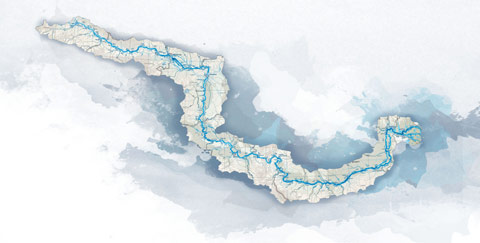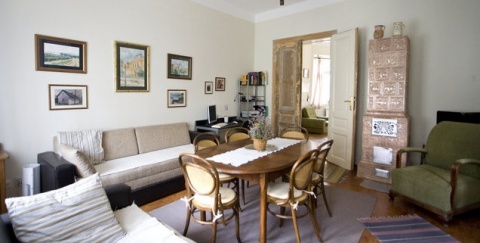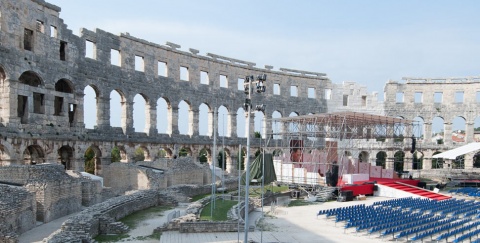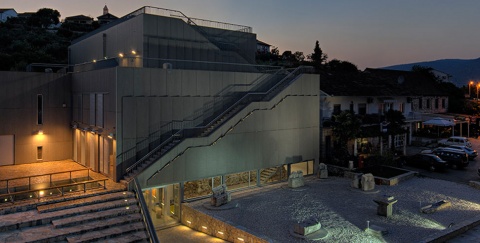
Kalelarga, also known as Široka ulica (“wide street”), is a street in Zadar (population: 75,000) that connects Narodni trg (People’s Square) with the Forum, the town’s main square. Some people believe that this road is older than the city itself. It follows the ancient Roman main city road (decumanus maximus). Roman urbanisation and street marking can still be seen in the Old Town of Zadar. Yet, the first settlers were not the Romans. In the 6th century BC, Zadar was a Liburnian settlement. Liburnians were known as excellent sailors and merchants.
Romans came in mid-2nd century BC, adopting the Greek name for the people living here Iadassinoi and calling the settlement Iader/Iadera. The promontory on which the old city stands used to be separated from the mainland by a deep moat which has since become landfilled. Although they were first Roman enemies in the Adriatic Sea, Liburnians mostly stood aside in the Roman wars against the Illyrians. In 59 BC, Iader became a municipality. Because it supported Julius Caesar against Pompey, Iader and the nearby Aenona (Nin) became Roman colonies in 48 BC. The construction of the city started with Emperor Augustus. The Forum (45 x 90 metres), finished in the 3rd century AD, had a capitol in the southwest, with a temple dedicated to Jupiter, Juno and Minerva. The monumental Roman column was used as “the pillar of shame” in the Middle Ages. There is evidence of the Roman era everywhere – towers, inscriptions and fortified walls. One of the Venetian-style city gates, the Sea Gate, also known as St Chrysogonus’ Gate because of its proximity to St Chrysogonus Church, consists of a Roman triumphal arch, commissioned by Auniana Melia in memory of her husband. The Venetian arch celebrates the victory over the Turks at Lepanto, in 1571.
The foundations of the first Christian buildings were laid here in Late Antiquity – Zadar became an Episcopal centre and has remained a seat of an archbishop of the Roman Catholic Church to this day.
St Anastasia’s Cathedral, a basilica in Romanesque style built in the 12th century, is the largest one in Dalmatia. Legend has it that a Roman woman, a patrician’s wife, was held under house arrest because she wanted to stay a virgin. After her husband’s death she moved to Aquila (Italy). According to legend, she was tortured during Diocletian’s exile and eventually burnt at the stake. Her relics were moved from Constantinople to Zadar in 804 AD by Donatus, the Bishop of Zadar. St Donatus’ Church is the symbol of Zadar. Built in 9th century AD and documented by Byzantine Emperor Constantine VII Porphyrogennetos, today it is a concert venue where Musical Evenings in Saint Donat take place. Visit Zadar’s other famous churches. Don’t miss the Archaeological Museum, which keeps artefacts from Neolithic to the medieval times. Zadar’s latest attraction, the Museum of Ancient Glass (Muzej antičkog stakla), is in the historic Cosmacendi House (1877) and hasthe biggest collection of ancient Roman glassware outside Italy.
Nin (population: 1,300), most famous for its beaches, is next to Zadar. In ancient Rome it was called Aenona (also Nona). Romans built a forum, an amphitheatre and the biggest temple on the Dalmatian coast here (1st century AD, under Emperor Vespasian). Eight statues of Roman emperors have been discovered in Nin. Among the most significant underwater findings are the remains of two serilia liburnica ships (1st century BC). They are 6 and 8 metres long and indicate excellent sailing skills of the ancient Liburnians. Recent excavations uncovered a rare Byzantine mosaic (17 x 30 metres) on the floor of a Roman villa.
Nin has been a spa since the Roman times. Peloid mud was used to heal skin diseases. The town was destroyed by the Avars and Slavs in the 7th century. Yet, this was not its end: Nin experienced a glorious revival as the first Croatian royal town and was a seat of the first Croatian bishop. Visit Sveti Križ, the Church of the Holy Cross (ca. 800 AD), which claims its fame as being the smallest cathedral in the world. Check out the two old Croatian boats from the 11th century at the Museum of Nin Antiquities and learn about salt at the Museum of Salt.
DANUBE.TRAVEL has no control over the website content generated by users and/or visitors, neither such content represents a statement, opinion, recommendation or rating by DANUBE.TRAVEL. For further information please refer to DANUBE.TRAVEL – General Website Terms and Conditions of Use.
 EN
EN DE
DE





_480x243.jpg)



